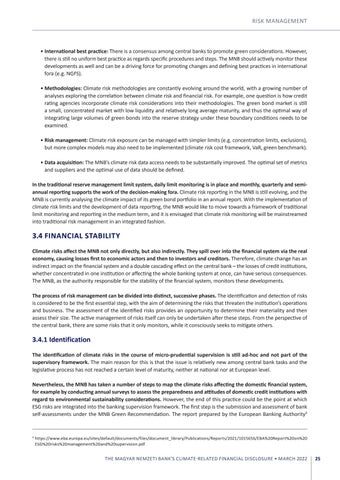Risk management
• International best practice: There is a consensus among central banks to promote green considerations. However, there is still no uniform best practice as regards specific procedures and steps. The MNB should actively monitor these developments as well and can be a driving force for promoting changes and defining best practices in international fora (e.g. NGFS). • Methodologies: Climate risk methodologies are constantly evolving around the world, with a growing number of analyses exploring the correlation between climate risk and financial risk. For example, one question is how credit rating agencies incorporate climate risk considerations into their methodologies. The green bond market is still a small, concentrated market with low liquidity and relatively long average maturity, and thus the optimal way of integrating large volumes of green bonds into the reserve strategy under these boundary conditions needs to be examined. • Risk management: Climate risk exposure can be managed with simpler limits (e.g. concentration limits, exclusions), but more complex models may also need to be implemented (climate risk cost framework, VaR, green benchmark). • Data acquisition: The MNB’s climate risk data access needs to be substantially improved. The optimal set of metrics and suppliers and the optimal use of data should be defined. In the traditional reserve management limit system, daily limit monitoring is in place and monthly, quarterly and semiannual reporting supports the work of the decision-making fora. Climate risk reporting in the MNB is still evolving, and the MNB is currently analysing the climate impact of its green bond portfolio in an annual report. With the implementation of climate risk limits and the development of data reporting, the MNB would like to move towards a framework of traditional limit monitoring and reporting in the medium term, and it is envisaged that climate risk monitoring will be mainstreamed into traditional risk management in an integrated fashion.
3.4 FINANCIAL STABILITY Climate risks affect the MNB not only directly, but also indirectly. They spill over into the financial system via the real economy, causing losses first to economic actors and then to investors and creditors. Therefore, climate change has an indirect impact on the financial system and a double cascading effect on the central bank – the losses of credit institutions, whether concentrated in one institution or affecting the whole banking system at once, can have serious consequences. The MNB, as the authority responsible for the stability of the financial system, monitors these developments. The process of risk management can be divided into distinct, successive phases. The identification and detection of risks is considered to be the first essential step, with the aim of determining the risks that threaten the institution’s operations and business. The assessment of the identified risks provides an opportunity to determine their materiality and then assess their size. The active management of risks itself can only be undertaken after these steps. From the perspective of the central bank, there are some risks that it only monitors, while it consciously seeks to mitigate others.
3.4.1 Identification The identification of climate risks in the course of micro-prudential supervision is still ad-hoc and not part of the supervisory framework. The main reason for this is that the issue is relatively new among central bank tasks and the legislative process has not reached a certain level of maturity, neither at national nor at European level. Nevertheless, the MNB has taken a number of steps to map the climate risks affecting the domestic financial system, for example by conducting annual surveys to assess the preparedness and attitudes of domestic credit institutions with regard to environmental sustainability considerations. However, the end of this practice could be the point at which ESG risks are integrated into the banking supervision framework. The first step is the submission and assessment of bank self-assessments under the MNB Green Recommendation. The report prepared by the European Banking Authority3
3
ttps://www.eba.europa.eu/sites/default/documents/files/document_library/Publications/Reports/2021/1015656/EBA%20Report%20on%20 h ESG%20risks%20management%20and%20supervision.pdf
THE MAGYAR NEMZETI BANK’S CLIMATE-RELATED FINANCIAL DISCLOSURE • MARCH 2022
25
